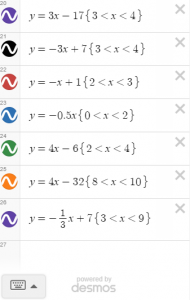What we learned Week 18 in Math 10 is just reviewing all units that we have been studying for a semester, for the final exam in Math 10.
The List of Top 5 (The Most Interesting) Things in Math 10
1. About Exponents (Week 4 in Math 10)
I learned some types of exponents. The steps learning more new information is always interesting, so the first unit of math 10 seemed like the review to me what we learned in grade 9, so, I thought we really began to learn the new information since we learned new types of exponents. I learned about some new types of exponents like fractions and negative numbers, new types of roots (radical signs) like a cube root, and how I can write radicals as a power and a power as a radical. I did not know the existence of cube root before I learnt it.
2. About Measurements (Week 5 in Math 10)
I could learn about units using to measure a height, a length, and a weight. I have not been using only km, m, cm, and mm for a length and only kg and g for a weight. I leant what k, h, da, d, c, and m are with using king henry doesn’t drink chocolate milk, and more measurements like a foot, an inch, a yard, m, g, µ, and n. In Canada and Korea, people do not use an inch, a foot, and a yard, they were kind of strange to me because I have never used and seen it except when I was reading books of some countries in Europe or American. Also, we learned some geometric formula and how we can use them.
3. About Trigonometry (Week 7 in Math 10)
It is the most interesting unit for me because I was fascinated that we can solve every right triangle with just some of the formula. With this unit, I could make math problems fun and interesting. We learnt what and where an opposite, a hypotenuse, and an adjacent, and how I can use them with Sine, Cosine, and Tangent. It was even pretty confusing because it was so easy to misunderstand where the side which we should use is.
4. About Relations and Functions (Week 13 in Math 10)
We learned what domains, range, relations, and functions are. The domain can be used for the input of the independent variable and the range can be used for the output of the dependent variable. Also, each element of the domain in a range and a function is a special type of relation. I even learned more graphs like a function notion. There are a lot of word problem and I am not comfortable in English yet, so in my opinion, it was the most difficult unit to me in math 10.
5. About Linear Relations
(Week 14 in Math 10)(Week 15 in Math 10)
I learned the slope formula (y1 – y2/x1 – x2) and these three different forms y-intercept form, general form, and point-slope form in linear graphs. The information what I learned in this unit was very useful when we should get the answer in the next unit (The systems of equations). It would keep using when precalculus 11, it might be the most important unit in Math 10.
+) 6. How to Factor Trinomials Easily
It was not one of the most interesting or difficult units in Math 10, but I could make the real interest in math. I had already learned about this unit in Korea where is my home country before I came to Canada, so I thought it would be same. However, I learned a new way to factor and simplify them. In South Korea, people just factored to write every single prime number and got the solution, so it was really unfair to people who were weaker about math than other smart people, and I was not so smarter other guys so my friends and I must be a human calculator for the test. But, I could learn there were infinite ways to get an answer as I learned a square of the factoring polynomials. Some of the new mathematical information was not very much like other units, but the interest in math came to me. So, it was not the most interesting unit, but it was the most valuable unit to me because this unit taught me the interest in math.
In my opinion, I could learn a lot of information about math, the way to solve many problems, and an interest in math more in this semester. I must quite struggle with math but I could really enjoy math for this semester, and I hope that the information and interests would not be disappeared until I finish studying math.












